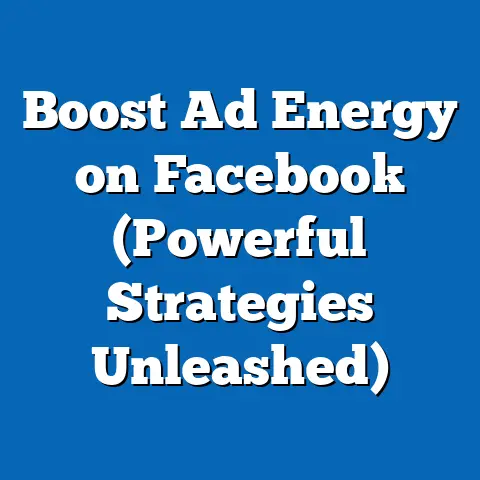Mastering Facebook Ads Customer Service (Expert Insights)
A common misconception among businesses using Facebook Ads is that once a campaign is launched, it requires little to no ongoing attention—a “set it and forget it” approach. This belief often leads to wasted ad spend, missed opportunities, and frustrated customers who feel ignored or misunderstood. In reality, effective Facebook Ads management, particularly in customer service, demands continuous monitoring, strategic adjustments, and a deep understanding of audience interactions.
According to a 2023 report by Hootsuite, businesses that actively engage with customers through social media platforms like Facebook see a 20-40% increase in customer retention compared to those that don’t. Furthermore, Statista notes that as of 2023, Facebook remains the largest social media platform globally, with over 2.9 billion monthly active users, making it a critical space for customer interaction. This article challenges the passive approach to Facebook Ads and dives into expert insights on mastering customer service through this powerful advertising tool, backed by data, trends, and actionable strategies.
The Importance of Customer Service in Facebook Ads
Why Customer Service Matters in Digital Advertising
Facebook Ads are not just about driving clicks or conversions; they are a direct line of communication between brands and consumers. Poor customer service in response to ad interactions can tarnish a brand’s reputation, with 89% of consumers stating they are more likely to make another purchase after a positive customer service experience, according to a 2022 Salesforce survey. Conversely, a negative interaction can lead to a loss of trust, with 54% of customers switching to a competitor after just one bad experience.
When customers comment on or message a business through a Facebook Ad, they expect quick, personalized responses. A study by Sprout Social in 2023 found that 70% of consumers expect a response within 24 hours, yet only 30% of brands meet this expectation consistently. This gap highlights the urgent need for businesses to prioritize customer service within their ad strategies.
The Scale of Interaction on Facebook
Facebook’s vast user base spans diverse demographics, making it a melting pot of customer expectations. As of 2023, Pew Research Center data shows that 69% of U.S. adults use Facebook, with usage highest among the 18-29 age group (81%) and still significant among those aged 50-64 (73%). Globally, eMarketer reports that 60% of internet users access Facebook at least once a month, emphasizing its role as a primary touchpoint for customer engagement.
These numbers underscore the potential reach of Facebook Ads but also the challenge of catering to varied audience needs. Younger users may prioritize fast, informal responses, while older demographics might value detailed, professional communication. Tailoring customer service to these nuances is critical for campaign success.
Historical Trends vs. Current Data: Evolution of Customer Expectations
How Customer Service Expectations Have Changed
Historically, customer service on social media was an afterthought for many businesses. In 2010, only 20% of companies actively responded to customer inquiries on platforms like Facebook, according to a study by Nielsen. By contrast, in 2023, Sprout Social reports that 76% of consumers expect brands to respond to their queries on social media, reflecting a seismic shift in expectations over the past decade.
This evolution is driven by the increasing integration of social media into daily life. A decade ago, customer service was primarily handled via phone or email, with response times often spanning days. Today, real-time interaction is the norm, fueled by the immediacy of platforms like Facebook, where 1.8 billion users engage with business pages monthly, per Meta’s 2023 business insights.
Current Trends in Facebook Ads Customer Service
Modern trends show a growing emphasis on personalization and automation in customer service. A 2023 HubSpot report indicates that 64% of customers want tailored experiences based on their past interactions with a brand, a demand that extends to responses on Facebook Ads. Simultaneously, the adoption of AI-driven chatbots has surged, with 58% of businesses using automated tools to handle initial customer inquiries on social platforms, according to Statista.
However, automation alone isn’t enough. While chatbots can handle basic queries, complex issues or negative feedback often require human intervention. Striking the right balance between efficiency and empathy is a key challenge for businesses today, as 62% of consumers still prefer human interaction for resolving complaints, per a 2023 PwC survey.
Key Strategies for Mastering Facebook Ads Customer Service
1. Proactive Monitoring and Rapid Response
The Need for Speed
Time is of the essence in addressing customer interactions on Facebook Ads. Meta’s own data reveals that businesses responding to messages within 5 minutes see a 40% higher customer satisfaction rate compared to those taking longer. Yet, a 2023 study by SuperOffice found that the average response time for businesses on social media is 10 hours—far beyond customer expectations.
Tools and Techniques
To close this gap, businesses should leverage monitoring tools like Hootsuite or Sprout Social to track comments and messages in real time. Setting up automated alerts for negative sentiment or urgent queries can prioritize responses. Additionally, assigning a dedicated social media team to handle ad-specific interactions ensures no customer is left waiting.
Case Study: Rapid Response Success
A 2022 case study by Buffer highlighted a small e-commerce brand that reduced its average response time on Facebook Ads from 12 hours to under 2 hours by using monitoring tools and a dedicated team. The result? A 25% increase in customer engagement and a 15% boost in conversion rates from ad interactions.
2. Personalization at Scale
Understanding Your Audience
Personalized responses resonate deeply with customers, but achieving this at scale requires data-driven insights. Facebook Ads Manager provides detailed demographic and behavioral data on ad audiences, such as age, location, and interests. A 2023 eMarketer report notes that brands using this data to tailor responses see a 30% higher engagement rate compared to generic replies.
Implementation Tips
Start by segmenting your audience based on ad campaign data. For instance, a campaign targeting millennials might use casual language and emojis, while one aimed at professionals could adopt a formal tone. Additionally, referencing a customer’s specific query or past interaction (if available) can make responses feel more individualized.
Visualization Description
Imagine a bar chart titled “Engagement Rates by Response Type,” showing two bars: one for generic responses (engagement rate: 12%) and another for personalized responses (engagement rate: 42%). This visual would underscore the impact of tailored communication on customer interaction, based on eMarketer’s 2023 findings.
3. Balancing Automation and Human Touch
The Role of Chatbots
Automation can streamline customer service, especially for high-volume campaigns. According to Gartner, businesses using chatbots on platforms like Facebook save an average of 30% on customer service costs. Tools like ManyChat allow businesses to set up automated responses for FAQs, appointment bookings, or order tracking.
Limits of Automation
However, over-reliance on bots can backfire. A 2023 Forrester study found that 54% of customers feel frustrated when automated responses fail to address their specific issue. For complaints or nuanced queries, human intervention is essential to demonstrate empathy and problem-solving.
Best Practices
Experts recommend a hybrid approach: use chatbots for initial contact and simple queries, but ensure a seamless handoff to a human agent for complex issues. Clearly communicate this process to customers—for example, a bot might say, “I’m transferring you to a team member for further assistance.” This transparency builds trust.
4. Handling Negative Feedback Effectively
The Impact of Negative Comments
Negative feedback on Facebook Ads can spread quickly, given the platform’s public nature. A 2023 BrightLocal survey found that 82% of consumers read online reviews before making a purchase, and negative comments on ads can influence perceptions. Ignoring or mishandling criticism can amplify damage, with 45% of customers sharing bad experiences on social media, per Zendesk.
Strategies for Resolution
Responding promptly and professionally to negative feedback is crucial. Acknowledge the customer’s concern, apologize if necessary, and offer a solution—publicly if appropriate, or via private message for sensitive issues. A 2022 Harvard Business Review study showed that businesses addressing complaints publicly on social media see a 20% higher customer loyalty rate than those who don’t.
Example in Action
Consider a hypothetical scenario: a customer comments on a Facebook Ad, “This product broke after one use!” A strong response might be, “We’re so sorry to hear this! Please send us a DM with your order number, and we’ll arrange a replacement right away.” This approach shows accountability and a willingness to resolve the issue.
Demographic Differences in Customer Service Expectations
Age-Based Variations
Different age groups interact with Facebook Ads in unique ways, influencing their customer service expectations. According to Pew Research Center (2023), 81% of 18-29-year-olds use Facebook, often expecting quick, informal responses—think emojis and slang. In contrast, only 40% of those over 65 are active on the platform, and they tend to prefer detailed, polite communication, per a 2022 AARP study.
Gender and Cultural Nuances
Gender can also play a role in interaction styles. A 2023 Statista survey found that women are 10% more likely than men to engage with brands on social media for customer service, often valuing empathetic responses. Cultural differences further complicate matters; for instance, customers in collectivist cultures (e.g., many Asian countries) may prioritize respect and formality, while those in individualistic cultures (e.g., the U.S.) might appreciate directness, according to Hofstede Insights data.
Tailoring Responses
Businesses must analyze their ad audience demographics using Facebook Insights to adapt their tone and approach. For example, a campaign targeting young women in the U.S. might use a friendly, supportive tone, while one aimed at older men in Japan could emphasize respect and professionalism. This nuanced understanding can elevate customer satisfaction significantly.
Data Visualization Description: Mapping Response Times and Satisfaction
Picture a line graph titled “Response Time vs. Customer Satisfaction on Facebook Ads.” The X-axis represents response time in hours (0 to 24), and the Y-axis shows customer satisfaction percentage (0% to 100%). The line starts high at 85% satisfaction for responses under 1 hour, dips to 60% at 5 hours, and plummets to 30% at 24 hours, based on Meta’s 2023 data. This visual would illustrate the critical importance of rapid responses in maintaining customer trust.
Challenges and Pitfalls to Avoid
Resource Constraints for Small Businesses
Small businesses often struggle with the resources needed for robust customer service on Facebook Ads. A 2023 Small Business Trends report found that 68% of small businesses lack a dedicated social media team, leading to delayed responses or inconsistent engagement. Investing in affordable tools like Buffer or hiring part-time staff can mitigate this issue.
Over-Automation Risks
As mentioned earlier, excessive reliance on automation can alienate customers. A real-world example comes from a 2022 incident where a major retailer’s chatbot repeatedly gave irrelevant responses to customer complaints on a Facebook Ad, resulting in a viral backlash. Businesses must regularly audit automated systems to ensure they align with customer needs.
Ignoring Negative Sentiment
Failing to address negative feedback is a critical mistake. A 2023 Edelman Trust Barometer report revealed that 59% of consumers lose trust in brands that ignore criticism on social platforms. Proactively monitoring sentiment and responding thoughtfully can turn detractors into advocates.
Broader Implications and Future Trends
The Growing Role of AI and Personalization
Looking ahead, the integration of AI in customer service for Facebook Ads is set to deepen. Gartner predicts that by 2025, 80% of customer interactions on social media will involve some form of AI, from predictive analytics for personalized responses to advanced sentiment analysis. However, the human element will remain crucial for building emotional connections, especially in high-stakes situations.
Shifting Customer Expectations
As younger, tech-savvy generations become the dominant consumer base, expectations for instant, seamless service will intensify. A 2023 Deloitte study projects that by 2030, 90% of Gen Z and millennial consumers will expect real-time responses on platforms like Facebook. Businesses must invest in technology and training to keep pace with these demands.
The Competitive Edge of Superior Service
Ultimately, mastering customer service in Facebook Ads offers a significant competitive advantage. With 74% of consumers willing to spend more with brands that provide excellent service (per a 2023 American Express survey), businesses that prioritize responsiveness, personalization, and empathy can build lasting loyalty. In an era where ad spend is increasingly scrutinized, turning customer interactions into positive experiences can maximize return on investment.
Conclusion
Challenging the misconception of a passive “set it and forget it” approach, this article has demonstrated that effective customer service is the backbone of successful Facebook Ads campaigns. From rapid responses (with 40% higher satisfaction for replies under 5 minutes, per Meta) to personalized engagement (boosting engagement by 30%, per eMarketer), the data is clear: active management pays off. As Facebook continues to dominate with 2.9 billion monthly users, and customer expectations evolve, businesses must adapt to stay relevant.
The broader implication is that customer service isn’t just a support function—it’s a strategic asset in digital advertising. By leveraging tools, understanding demographic nuances, and balancing automation with human touch, brands can transform Facebook Ads into a powerful platform for connection and growth. As trends point toward greater AI integration and real-time interaction by 2030, the time to master this space is now.





